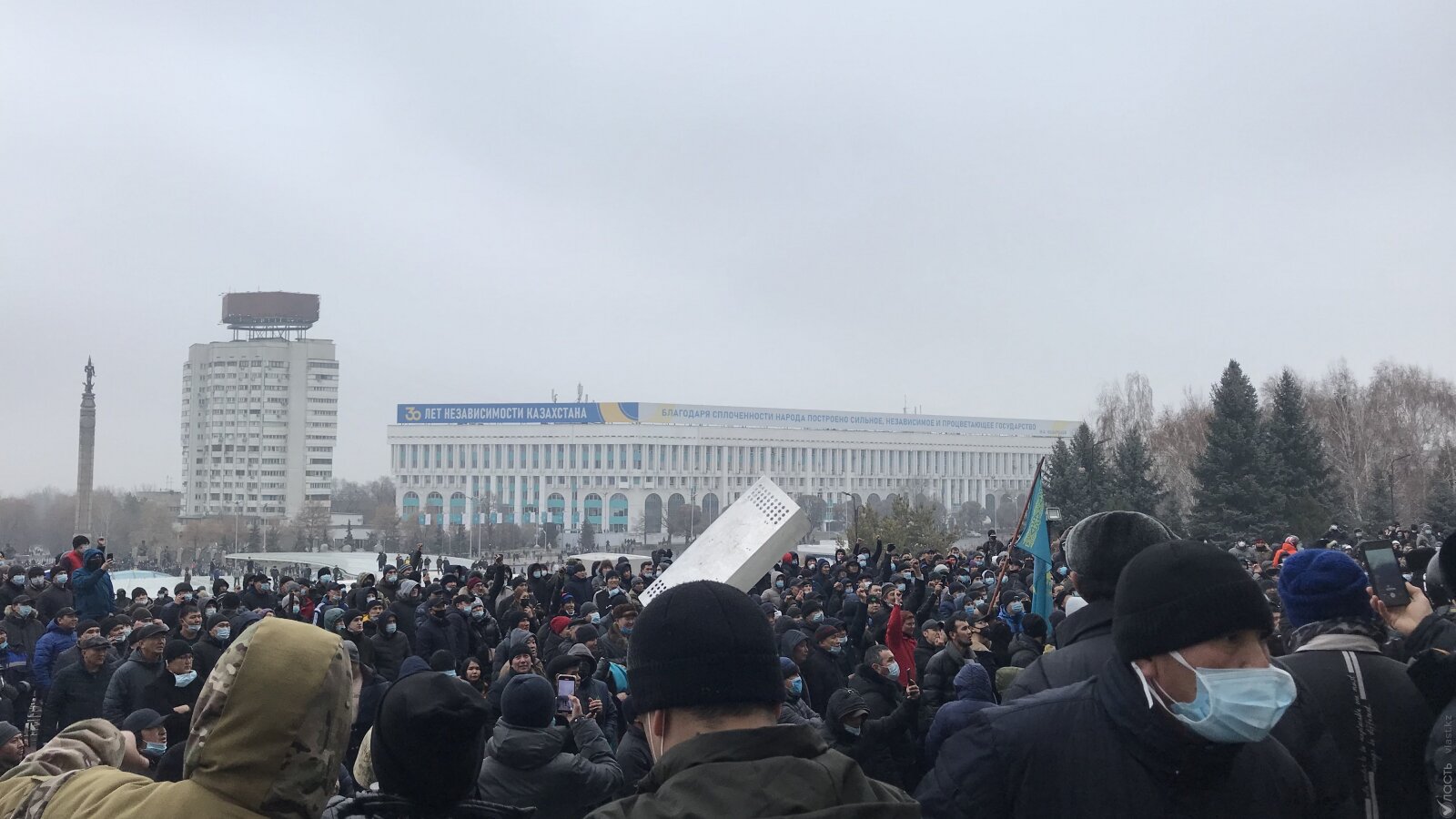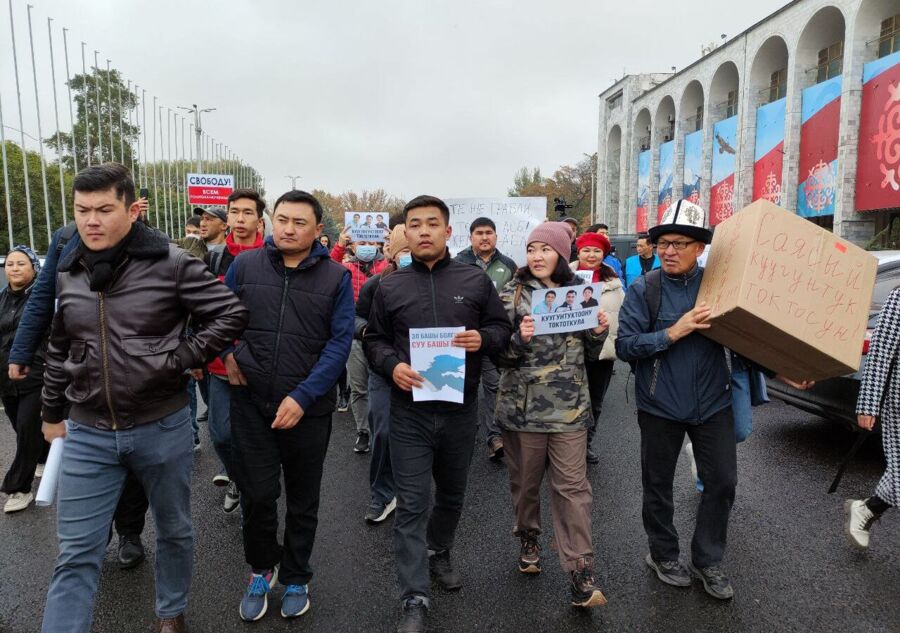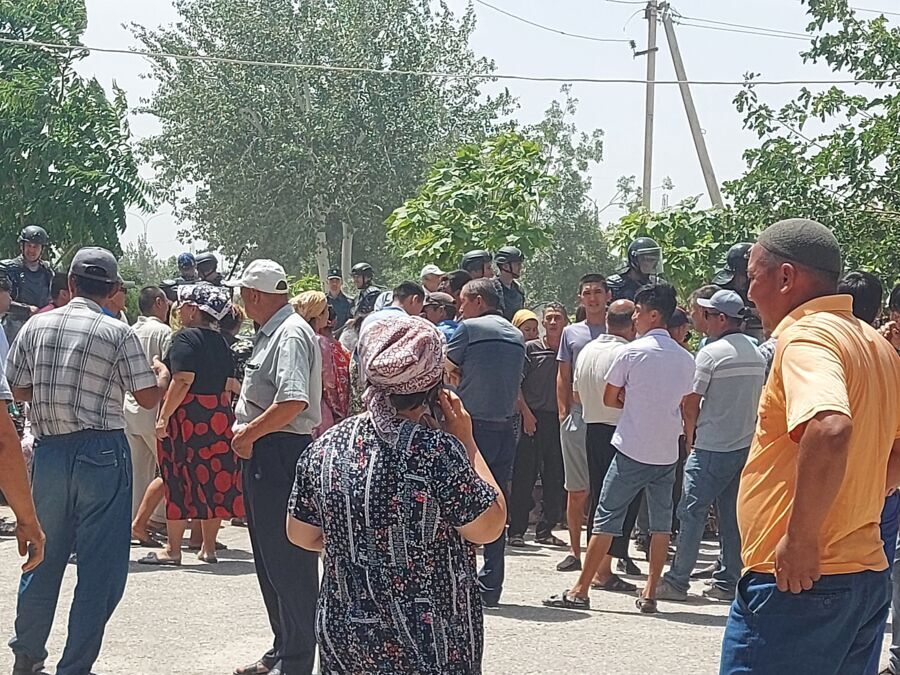For the last few years, Central Asian countries have faced a series of political and economic upheavals. Inequality and poverty are on the rise because their governments are not committed to a more equitable economic redistribution. The population reacts with mass protests, which the governments forcibly suppress, offering nonfunctional solutions. All this strengthens the authoritarian character of the political regimes, driving their legitimacy to a crisis. Experts predict that the region could be slated for new social tension.
Central Asian economies have hit a downward slide because of the COVID-19 pandemic and the war in Ukraine. Franco Galdini, a postdoctoral fellow at Manchester University researching the political and economic transformation of the region since 1991, told Vlast that the structure of these economies has left the population in a vulnerable position.
The state budgets rely on commodities export in exchange for foreign currency. This system does not allow the countries in the region to build domestic industrial production supply chains in order to provide the population with sufficient income and jobs.
“Industrial manufacturing is mostly sustained by raw material rents, growing when raw material prices are high and falling when these prices fall. These raw material rents are allocated through government bureaucracies, often on an individual basis, leading to high levels of corruption.” explains Galdini.
Elmira Satybaldieva, senior fellow at the Conflict Analysis Research Center at the University of Kent, explained that for 30 years Central Asian states have not been able to overcome their economies’ dependence on raw materials. Only Kyrgyzstan has come close to this goal, but mainly on account of the depletion of reserves at Kumtor, the largest gold mining site in the region.
“It is very difficult for countries of the region to attract foreign investment in the industrial production sector, except for Kazakhstan and Uzbekistan, which manage with their own resources,” Satybaldieva told Vlast.
Despite a difficult economic situation, Central Asian societies remain quite depoliticized. One of the reasons is the neoliberal policy of Western countries, which narrows the idea of statehood in the region, linking it only to rent extraction.
“The world community initially did not have plans to promote democracy in the region. It was only interested in access to cheap raw materials. In this regard, neoliberal policies and democracy are not very compatible, and even contradict one another,” Satybaldieva said.
Under democracy, Central Asian leaders would not have been able to abruptly carry out the privatization, deregulation of financial markets, and cuts in social spending that was painful for most of the population.
According to Satybaldieva, the implementation of neoliberal reforms ultimately leads to state capture by a group of elites and the concentration of capital in the hands of a small fraction of the population. The gigantic social divide that follows undermines the legitimacy of the ruling class.
Protests and Repression
Despite the depoliticization of Central Asian societies, economic troubles, and a legitimacy crisis, people choose to protest en masse. In 2022, protests dotted almost the entire region.
Rallies across Kazakhstan spread after a sharp increase in prices for liquified gas. An attempt to repeal constitutional laws regarding the sovereignty of the Karakalpakstan region spurred protests in Uzbekistan. Residents and activists protested against the transfer of the Kyrgyz Kempir-Abad reservoir to Uzbekistan and political repressions. Residents of the Gorno-Badakhshan Autonomous Region (GBAO) in Tajikistan took to the streets after a series of killings and arrests of civilians.
These protests quickly integrated social demands. People expressed dissatisfaction with inequality and injustice. In Kazakhstan, Uzbekistan, and Tajikistan this turned into clashes with security forces and the killing of civilians. Not one country allowed for an impartial and transparent investigation of these events.
Following the protests, a new wave of repression swept over these countries.
In Kazakhstan, it manifested through pressure on political activists and journalists. In Karakalpakstan, the Uzbek government practically suppressed all civil society activities. In order to prevent people from organizing, authorities in Tajikistan have banned prayer gatherings in private homes in GBAO, only allowing group prayers in the two official Ismaili centers in the country. In Kyrgyzstan, journalists and citizen activists have been persecuted. The country’s authorities accused several politicians and activists of preparing a coup d’etat and arrested them.
Inflation, War, and Poverty
In recent years, inflation has represented a problem for the countries in the region. It jumped on the back of supply chain failures, increasing fuel prices, and rising food prices. In addition, economies in the region are being negatively affected by an energy infrastructure crisis that has caused rolling black outs.
After an initial depreciation after the war, the strengthening of the Russian ruble has increased incomes of labor migrants from Tajikistan, Kyrgyzstan and Uzbekistan, whose GDPs heavily depend on remittances from Russia. This factor, along with the re-export of goods to Russia and the influx of money from Russians fleeing to Central Asia to avoid the draft, eased their economic downturn. The economies of Turkmenistan and Kazakhstan were also positively affected by rising energy prices.
However, this did not solve the structural problem of the “working poor” in the region.
In Kazakhstan at least 2.1 million people are self-employed: 81.4% of these earn less than $443 in a month - the median wage in the country. In addition, 1.1 million people work informally.
In Kyrgyzstan, more than one million citizens are working abroad, because of a lack of stable jobs in their own country (this is almost half of the working-age population). But the number of labor migrants from Tajikistan is about 700,000 (approximately 30% of the economically active population of the country).
In Uzbekistan more than 2.3 million people have left the country in search of work, and almost half of the working-age population is employed in the informal sector.
“Overall, if we exclude industrial workers as well as workers in some services such as finance, the standard of living for the great majority of the working class is either stagnating or falling,” Galdini said.
While Central Asian governments have reacted differently to the worsening economic positions of the people, the main response has been a policy of “belt tightening.”
Salaries of public sector workers as well as welfare contributions were erratically increased and the effect of these measures was offset by the rise in prices of goods and services, especially food, which accounts for 40-50% of the expenses of all households.
In response to the energy crisis, Central Asian governments decided to increase tariffs on utilities and electricity. In Uzbekistan energy-intensive enterprises were privatized.
In addition, Kazakhstan and Uzbekistan, the largest raw material exporters, have failed to improve their own production bases.
A Crisis of Legitimacy
The economic downturn has worsened an already tangible crisis of legitimacy in Central Asia’s ruling class.
In Kazakhstan, Kyrgyzstan and Uzbekistan, new political leaders are consolidating their control, while the leadership in Tajikistan and Turkmenistan remains solidly at the helm. In both instances, real systemic change has not surfaced.
Luca Anceschi, professor of Central Asian studies at the University of Glasgow, took the example of Qandy Qantar (Kazakh for “Bloody January”, the violent repression of urban protests and riots that shook the country last year), to show the gap between people’s demands and regime stability.
“Qandy Qantar revealed the fragility of regimes that do not address demands for political change while ignoring the population’s economic grievances: repression is the only long-term solution to guarantee regime stability." Anceschi told Vlast.
After the events of January 2022, President Kassym-Jomart Tokayev announced the creation of a “New and Just Kazakhstan,” calling for a referendum on constitutional amendments and early presidential and parliamentary elections. These elections kept civil society representatives at bay and became examples of mass falsifications. Despite the president’s statements on the “unacceptability of social inequality”, the cumulative wealth of the richest people in Kazakhstan grows, while the regime continues to be hostile to citizen protests.
Since the protests in GBAO, repression in Tajikistan has continued, against the backdrop of the transit of power from President Emomali Rakhmon, who has ruled the country since 1994, to his son Rustam Emomali, who already sits in high positions of authority. In recent years at least eight journalists were arrested and several independent human rights centers were shut down. Tajik activists who fled to Russia continue to be abducted and their relatives detained.
Despite having repealed the constitutional amendments depriving Karakalpakstan of autonomy, Uzbekistan’s President Shavkat Mirziyoyev continues his predecessor’s authoritarian practices. While announcing a “new Uzbekistan” policy, with a focus on economic liberalism and amnesty on part of “political prisoners,” Mirziyoyev held a constitutional referendum giving him the possibility to be re-elected for two more terms [note: on July 9, he was, in fact, re-elected for one more term]. While the country went to the polling stations, Karakalpak activists continued to be detained and political competition continued to be stifled.
In Kyrgyzstan, President Sadyr Japarov, who came to power after another “revolution” in October 2020, is now also strengthening his clout through constitutional change.
Japarov’s coup was a response to the desires of the people, wishing to see a charismatic leader as the head of their country, a strong hand who would be able to rise above the former elites and solve the economic problems of the majority of the population. Japarov and his entourage seized this opportunity to return the country to a super-presidential form of rule and captured all major assets.
In a pithy comment, researcher and journalist Bruce Pannier highlighter the lack of change Turkmenistan since former President Gurbanguly Berdymukhamedov handed over the top job to his son, Serdar, last year.
“Turkmenistan is the same as it always was, perhaps a bit worse,” Pannier told Vlast.
“Serdar becoming president has not changed anything. In fact, Serdar becoming president just confirms to people in Turkmenistan that nothing will change.”
This year, however, a reform allowed Berdymukhamedov senior to chair the upper house of parliament, the Khalk Maslakhaty, so that all the important political decisions cannot be implemented without the consent of the ex-president.
According to Pannier, “the return of Gurbanguly to active politics seems to be just a sign that the son was not ready to be president.”
An important circumstance, in which all these political processes are developing, is the war in Ukraine and the consequent intensification of geopolitical spats.
This situation, for Central Asian governments, offers both benefits and threats. The benefits are that the marginalization of Russia by the West gives them a better negotiation position against Russia, the largest economy in the post-Soviet space. On the other hand, the leaders’ own legitimacy, depends on Russian protection, as seen during Qandy Qantar in Kazakhstan.
The legitimacy of old and new Central Asian leaders rests on the assumption that only they can keep their countries safe in times of economic and geopolitical problems. They decide when and how to restructure the social system and to respond to demands for social justice and foreign policy stability. This gives them the basis to act as the sole political representatives of the people, thereby overshadowing other political institutions and opposition forces.
What Future for Central Asia?
"In Central Asia, regime-imposed ideas of progress are now entrenched in the illusion of novelty: New Kazakhstan, New Uzbekistan promoted by Tokayev and Mirziyoyev. While I can see the gap between Karimov’s policies and the process of authoritarian modernization in Uzbekistan, which is nevertheless losing momentum, I struggle to understand what is new in post-Nazarbayev Kazakhstan," says Luca Anceschi.
Temur Umarov, fellow at the Carnegie Center for Russian and Eurasian Studies in Berlin, says that the new Central Asian presidents in Kazakhstan, Uzbekistan and Kyrgyzstan have not implemented and will not execute any structural reforms. Tajikistan and Turkmenistan, as always, maintain their focus on regime stability.
“But the regimes are still becoming more flexible: they listen, recognize some problems, because they live in a different, more technological world with a younger and more active population. Of course, there are some changes happening,” Umarov told Vlast.
The old political elite acknowledges the populist demands and adapts its course, Satybaldieva argues. According to her, the result is the creation of decorative political institutions and the illusion of a fight against corruption, in which the presidents target certain representatives of the elite and force them to “voluntarily” return their capital to the country.
“But no one is placing their efforts into the redistribution of resources,” Satybaldieva said.
Because of a lack of top-down alternatives, the environment is ripe for social upheavals. Sooner or later the resources that make up the backbone of Central Asia’s economies will run out, causing a budget crisis, summarized Satybaldieva.
Galdini added that giving a priority to raw material exports over local industrialization has long contributed to unemployment and underemployment.
Without an increasingly intensive repression, it will not be possible to keep the poorest strata of the population from protesting.
Umarov emphasized that a split among the elites still represents a major risk for Central Asian regimes. And this may materialize during the next power transitions.
“Tokayev, Mirziyoyev and Rakhmon are not young. Sooner or later they will need to think about how to prolong their political life. It's a fragile process and a lot can go wrong,” he said.
Поддержите журналистику, которой доверяют.











